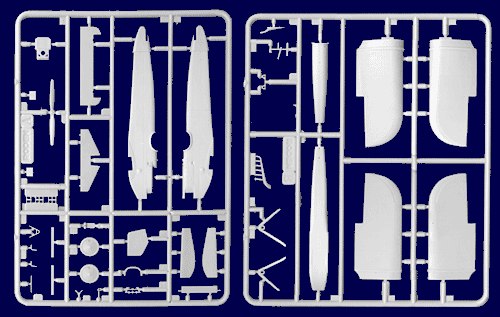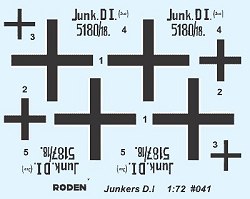|
KIT: |
Roden 1/72 Junkers D.I |
|
KIT #: |
041 |
|
PRICE: |
$8.98 MSRP ($7.96 at
Squadron) |
|
DECALS: |
Two options |
|
REVIEWER: |
Scott Van Aken |
|
NOTES: |
|

The rapid development of aviation
during the First World War was mainly aimed at improving the principal
characteristics of aircraft-speed, maneuverability, and range.
Structurally, airplanes of that period remained descendants of the Wright
brothers' very first flying machine-they were still produced from the
traditional materials of wood and canvas; structural strength was
attained with the help of numerous bracing wires. But there were certain
particular warplanes, some of which barely had time to take part in
combat, essentially differed from all the rest-the Junkers J I, Junkers
CL I and Junkers D I. These airplanes were of a completely new type. They
were a great advance for there time-their design consisted entirely of
metal. Their design fundamentals were simple-a framework of thin
duraluminum tubes was covered with sheets of corrugated aluminium. The
ingenious German designer and inventor Hugo Junkers patented this idea in
1912. It became the basis of his theoretical development "of a thick
cantilevered wing". After the beginning of the First World War Junkers
convinced Idflieg of the potential of his development. The Junkers J I, a
heavily armored ground attack plane, made its first flight in the winter
of 1916. This airplane has become famous, because none of the Allies
could bring down any of these machines during the war.
Convinced of the correctness of this development, Junkers began designing
a special operational-support plane for the army, the CL I; and a
fighter, the D I.
The first flight of the J.7, prototype of the future fighter, was in
September 1917. The revolutionary design was confronted by a great
variety of problems, which were atypical of conventional
aircraft-vibration of wings in flight, bad controllability of ailerons,
amongst others. But the biggest problem was the absence of a suitable
engine, because the best engine was the Mercedes D.IIIa, which developed
only 160 hp. It was enough for a traditional machine, but the completely
new metal design was much heavier. Nevertheless, the aircraft was sound
and not meant for aerobatics, so Junkers persevered with the new
technology.
During the Second Fighter Competition in July 1918, Junkers entered into
competition not only the J.7, but also the new J.9 (D I), with many
modifications to the overall design: the shape of the fuselage was
changed, the wing span was increased, and the ailerons also were of
changed form. The greatest pilots participated in these Competitions, and
their observations about the metal machines did appear disapproving-Bruno
Loerzer and Hermann Goering recommended it strictly as "an airplane for
struggle with balloons and airships". This low-wing monoplane, an unusual
design for the time, naturally had a limited view downwards from the
cockpit, and this also has resulted in disapproval from the pilots.
Nevertheless the Idflieg ordered a series of 40 aircraft, but by the end
of the war the Junkers firm had built only 15 machines (12 by February
1919, when all military production was stopped by order of the Allies).
The affiliated company, Junkers-Fokker, constructed 13 machines of the D
I type. The first aircraft had long fuselages (later ones were to the
shorter design). In the beginning of October 1918 these machines were
sent to the Flanders sector, but the war approached its end and the
Junkers D I was not in time to take much part in the fighting. In
conditions of autumn rain Junkers' aircraft had essential advantages over
wood and linen types-metal machines were not subject to the whims of the
weather, while the canvas and wood of other machines deteriorated all too
quickly.
After the end of the war the Junkers aircraft had an opportunity once
again to prove their advantages: German air forces assisted the
governments of the Baltic countries in their struggle against Russia in
the spring of 1919. The commander of the division, Lt. Gotthard
Sachsenberg, remarked that the metal Junkers D I was the best choice for
the constantly adverse weather conditions.
Without doubt only two events were truly radical advances in aircraft
technology during the First World war-the invention of the gun
synchronizer, and the creation of completely metal aircraft designs. The
further development of fighter aviation was determined by these two
events, and consequently Hugo Junkers rightfully became regarded as one
of the parents of modern aircraft.
Thanks to Roden for the historical
background.

Roden's Junkers D.I is one of their
better molded kits. The corrugations are extremely well done and have to be
seen in person to really be appreciated. There is one sprue that is what
I'd call 'basic German aeroengine' that has been used on a number of other
German WWI projects like their Albatros and Fokker fighters that is not
shown. It makes good marketing sense to include this somewhat generic sprue
and it cuts down on development costs. The ot her
two sprues are brand new and on my example were totally free of flash, sink
areas (which on a corrugated surface would be impossible to properly fix),
or ejector pin marks. I did notice that the exhaust had rather prominent
mold seams and the generic sprue was a bit flashy, though minimally so.
From what I could see, there were not really any optional parts and
frankly, for a plane that saw such little combat, you'd be surprised if
there were. I do like the idea of separate elevators and ailerons as those
kinds of thins add some life to an aircraft.
her
two sprues are brand new and on my example were totally free of flash, sink
areas (which on a corrugated surface would be impossible to properly fix),
or ejector pin marks. I did notice that the exhaust had rather prominent
mold seams and the generic sprue was a bit flashy, though minimally so.
From what I could see, there were not really any optional parts and
frankly, for a plane that saw such little combat, you'd be surprised if
there were. I do like the idea of separate elevators and ailerons as those
kinds of thins add some life to an aircraft.
Instructions are quite well done and
typical of what Roden has been doing in the past years so no need to really
dwell on that aspect. The decals are very well printed and for two
aircraft; differing only by the serial number. I have to approach Roden
decals with some caution as they have not been very amenable to setting
solutions and have shown a tendency to be brittle. Though one doesn't know
until it is time to use them, I hope these are an improvement because they
have to be able to snuggle down into all those corrugations. I'd have a set
of aftermarket insignia around just in case.
Thanks to Roden, we now have a mainstream Junkers D.I.
Previously it was only available in this scale as either a resin kit or a
short run version. Thanks to its cantilever design, this one won't need any
rigging save for two wires on the landing gear. For those who like old
planes but suffer from rigging-phobia, this is a perfect model for you!
You can find this kit and many others at

If you would like your product reviewed fairly and fairly quickly by a
site that has over 250,000 visitors a month, please
contact
me or see other details in the
Note to
Contributors.
Back to the Main Page
Back to the Review
Index Page
Back to the Previews Index Page



 her
two sprues are brand new and on my example were totally free of flash, sink
areas (which on a corrugated surface would be impossible to properly fix),
or ejector pin marks. I did notice that the exhaust had rather prominent
mold seams and the generic sprue was a bit flashy, though minimally so.
From what I could see, there were not really any optional parts and
frankly, for a plane that saw such little combat, you'd be surprised if
there were. I do like the idea of separate elevators and ailerons as those
kinds of thins add some life to an aircraft.
her
two sprues are brand new and on my example were totally free of flash, sink
areas (which on a corrugated surface would be impossible to properly fix),
or ejector pin marks. I did notice that the exhaust had rather prominent
mold seams and the generic sprue was a bit flashy, though minimally so.
From what I could see, there were not really any optional parts and
frankly, for a plane that saw such little combat, you'd be surprised if
there were. I do like the idea of separate elevators and ailerons as those
kinds of thins add some life to an aircraft.